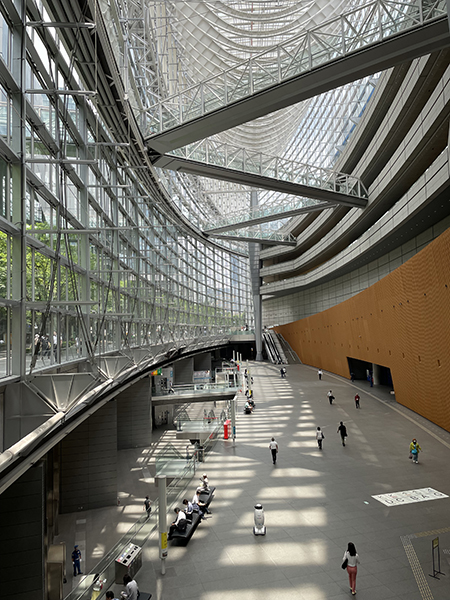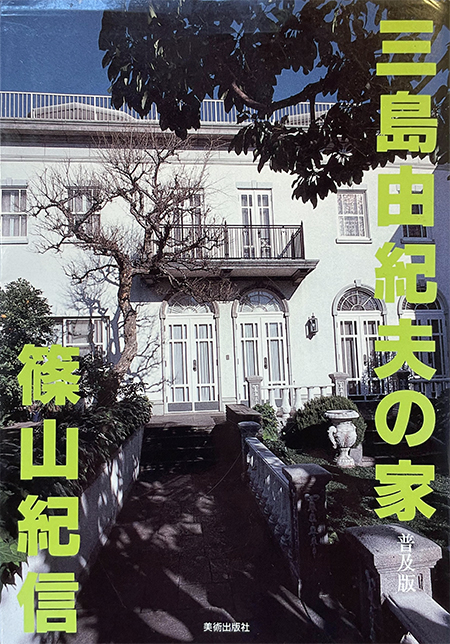
写真は前回の東京出張でイベントの開かれていた有楽町−東京の間に建っている「東京国際フォーラム」の内観の様子です。こちらの建物は旧・東京都庁舎の敷地跡に建てられたもので、国際設計コンペの結果、設計者:ラファエル・ヴィニオリ(Rafael Viñoly)構造設計:渡辺邦夫で1997年1月10日に開館し、株式会社東京国際フォーラムが運営する建物。
ちょうど「事業再構築」補助金活用の企業群事例を紹介するイベントがあってはじめて足を踏み入れた次第。わたしは東京での仕事生活時代、有楽町〜日比谷のオフィスで働いていましたが、有楽町のJR駅を挟んで反対側だったのでちょっと縁遠かったのかなぁと思っていたけれど、よく考えたらわたしは1980年には北海道にUターンしていたので、時間的にこの建築とは時代が違っているのですね。
どうしてこの建物のことが気になっていたかというと、こちらを訪問後、ある案件に関連して「三島由紀夫の建てた自宅」について調べるために篠山紀信さんが撮影した写真集「三島由紀夫の家」を購入し熟視・熟読していたのです。
三島由紀夫の家はどうやらいまも東京都大田区南馬込に現存するようですが、公開などは一切されず近親の方が住まわれている。そういうことでこの写真集が唯一の手掛かりなのです。

三島事件とは1970年(昭和45年)11月25日に作家の三島由紀夫(本名・平岡公威)が、自衛隊に決起を呼びかけた後に割腹自殺をした事件。その衝撃があまりにも大きく、作家に触れることは一種のタブーであったように思います。「三島事件」とWEB検索すれば生々しい事件の記憶が甦ってくる。ただ、住宅関係者としてはそういった背景を頭に入れながらもこの作家の住宅自体についての興味は強い。
で、この本の中で唯一のテキストが美学評論家・篠田達美氏によって書かれていて、いわば作家の創作意欲と住空間の関連性について書かれていたのです。非常に難解な文章表現だけれど、センシティブな三島事件とは距離を置きながら三島個人の内面と住宅の関係について、書かれていた。
この篠田達美氏は上で紹介した「東京国際フォーラム」建築の建設に際して、主要な施主的決定者「審議委員」を務められてもいることがわかって、こういった事実関係を知ってさらにふしぎな巡り合わせと思った次第。自分で撮影したこの建物の写真と、篠山紀信さんの撮影写真集とが頭のなかで交差し、同時に三島由紀夫事件とが渾然一体となって、刺激的にブレンドされている(笑)。さらにいえばこの建物を訪れた要件(事業再構築案件)もすっかり忘却させられてしまっていることもある。
人間の行動ってなにかの流れ、導きのようなものが背景にあるのかも知れませんね。
English version⬇
[Business trip to Tokyo starting today, struggling with the extreme heat? (Laughs)
Oh, I will never struggle with it. I will just go from air-conditioned space to air-conditioned space, quietly and casually, with patience and self-restraint, and spend my time in an indifferent manner. I will just spend my time quietly, patiently, and with self-effacement.
The photo shows an interior view of the Tokyo International Forum, which stands between Yurakucho and Tokyo, where an event was held during my last trip to Tokyo. This building was built on the site of the former Tokyo Metropolitan Government Building and opened on January 10, 1997 as a result of an international design competition by Rafael Viñoly (architect) and Kunio Watanabe (structural engineer), and is operated by Tokyo International Forum, Inc.
I visited the building for the first time at an event to introduce a case study of a group of companies utilizing “business restructuring” subsidies. During my working days in Tokyo, I worked in an office between Yurakucho and Hibiya, which was on the opposite side of the Yurakucho JR station, so I thought I was a bit out of touch with this building, but when I thought about it, I had made a U-turn to Hokkaido in 1980, so the time period is different from that of this architecture. I wondered why I was interested in this building.
The reason why I was interested in this building is that after my visit to Hokkaido, I bought a book of photographs taken by Kishin Shinoyama, “The House of Mishima Yukio,” and read it carefully in order to research “the house built by Yukio Mishima” in connection with a certain project.
Apparently, Yukio Mishima’s house still exists in Minami-Magome, Ota-ku, Tokyo, but it is not open to the public and is occupied by his next of kin. This photo album is the only clue we have.
The Mishima Incident is the case of writer Yukio Mishima (real name Kimitake Hiraoka), who committed suicide on November 25, 1970, after calling on the Self-Defense Forces to make a decision. The shock was so great that it was a kind of taboo to mention the writer. A Web search for “Mishima Incident” will bring back vivid memories of the incident. However, as a person involved in housing, I have a strong interest in the artist’s housing itself, even while keeping such background in mind.
So, the only text in the book was written by Tatsumi Shinoda, an aesthetics critic, so to speak, about the relationship between the artist’s creativity and the housing space. It was written in a very difficult style, but it was about the relationship between Mishima’s personal life and housing, while keeping a distance from the sensitive Mishima Incident.
I was further mystified to learn that Mr. Tatsumi Shinoda was also a member of the “deliberation committee” that made the major decisions regarding the construction of the “Tokyo International Forum,” which I mentioned above. The photos I took of the building and Kishin Shinoyama’s photo book intersect in my mind, and at the same time, the Yukio Mishima incident is blended together in a stimulating way (laugh). What is more, the requirement to visit this building (the business restructuring project) has also been completely forgotten.
Human behavior may have some kind of flow or guidance in the background.
Posted on 7月 26th, 2024 by 三木 奎吾
Filed under: 日本社会・文化研究







コメントを投稿
「※誹謗中傷や、悪意のある書き込み、営利目的などのコメントを防ぐために、投稿された全てのコメントは一時的に保留されますのでご了承ください。」
You must be logged in to post a comment.